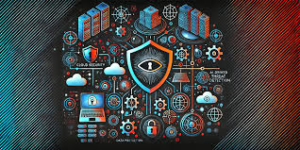Cybersecurity Awareness Month presents a valuable chance for both public and private entities to reflect on their cybersecurity objectives, evaluate their achievements, and prepare for future challenges. In light of this, let’s explore five emerging trends that are reshaping the landscape of our security strategies in the ongoing battle against cyber threats.
The Role of Artificial Intelligence in Combating Cybercrime

Artificial Intelligence (AI) has emerged as a formidable ally in the war against cybercrime. Its remarkable ability to sift through enormous volumes of data enables it to recognise patterns and identify potential signs of an attack before they escalate. AI proves invaluable not only in detecting malicious activities within systems or networks but also in uncovering anomalies or suspicious behaviours that might otherwise go unnoticed.
Moreover, AI streamlines many tedious cybersecurity tasks that typically consume significant time and effort. By automating these processes, cybersecurity teams can redirect their focus toward more critical aspects of their operations, enhancing overall effectiveness.
However, while the cybersecurity sector is keenly exploring ways to leverage AI to thwart cybercriminals, it is crucial to acknowledge that these criminals are also harnessing AI technology. They utilise it to accelerate execution, broaden the scope, and intensify their attacks.

Take phishing schemes as an example; they have evolved from rudimentary deceptive emails into sophisticated traps that are increasingly difficult to detect and dangerous. Cybercriminals now employ deepfake technology—an advanced form of AI capable of generating highly realistic images, sounds, and videos—to carry out fraudulent activities or manipulate individuals into taking actions they otherwise wouldn’t consider.
The adaptability inherent in AI further amplifies its threat during social engineering attacks—strategies designed to exploit human psychology by tricking individuals into divulging sensitive information or compromising security protocols. By employing AI-driven tactics, cybercriminals can present themselves as more credible figures or organisations. This increased trustworthiness often leads unsuspecting victims down a treacherous path toward fraud or manipulation, which can culminate in severe breaches of security systems.

In summary, while Cybersecurity Awareness Month encourages organisations to assess their defences against growing cyber threats actively, it simultaneously underscores the dual-edged nature of technological advancements like artificial intelligence—a tool with immense potential for both protection and peril.
In recent years, the rapid advancement of artificial intelligence (AI) technology has increasingly integrated itself into the realm of cybersecurity. At Maxthon, our team of security specialists is dedicated to assisting clients in developing automated security measures powered by AI. These systems enable organisations to respond swiftly and accurately to cyber threats, thereby minimising potential downtime and safeguarding both personal and critical business data.
As we navigate a world where digital connectivity permeates every aspect of our lives, from smartphones and applications to social media platforms and messaging services, the risk landscape for both individuals and organisations has grown significantly. The surge in cybersecurity incidents has paralleled the rise of remote work as cybercriminals exploit the expanded vulnerabilities that come with this shift. Traditional perimeter security measures that once protected office environments are now inadequate for safeguarding employees who operate in this new hybrid landscape filled with interconnected devices.

Our reliance on mobile phones and their myriad applications has transformed how we communicate—from receiving real-time updates from friends on social media to sharing professional milestones on LinkedIn or immersing ourselves in gaming experiences. This heightened connectivity presents a wealth of opportunities for malicious actors who may seek to capture your attention or target you or your loved ones for online scams or harassment. Consider this: a seemingly innocuous click on a link shared via WhatsApp could lead you straight into a web of cyber threats, jeopardising not only your personal information but also compromising sensitive data belonging to your organisation.
Moreover, the habit of oversharing details about personal milestones or professional achievements on social platforms can inadvertently expose both yourself and your employer to potential risks. For years now, businesses have been grappling with Shadow IT—unauthorised devices and systems connecting to corporate networks—which can create gaps in security protocols, compliance challenges, and an increased likelihood of data breaches.

Today’s concern extends beyond Shadow IT; we are now confronted with the emergence of Shadow AI—the unauthorised use of AI tools within organisations without oversight or control. This new frontier introduces its own set of vulnerabilities that demand our attention as we strive to maintain robust cybersecurity practices amidst an ever-evolving technological landscape.
In today’s digital landscape, safeguarding sensitive resources within the workplace is more critical than ever. One practical approach to achieving this is through the implementation of a zero-trust strategy. This cybersecurity framework operates on the principle that every user must be authenticated and authorised for each level of access within a network. Even if an individual device falls victim to a breach, maintaining strict controls can thwart unauthorised access and protect against potential compromises. It’s essential to understand that zero trust is not merely a standalone solution; instead, it serves as a guiding philosophy that integrates seamlessly with advanced technologies. At Maxthon, our experts are dedicated to assisting clients in navigating their unique paths toward adopting this transformative approach.
Moreover, the threat landscape extends beyond corporate networks; it infiltrates critical infrastructure and even our homes. When power outages occu,r or gas supplies are interrupted, most individuals don’t immediately suspect cyberattacks as the root cause. However, operational technology (OT) has emerged as a significant target for malicious actors intent on wreaking havoc on society’s backbone—systems responsible for automating factories and managing essential services such as power generation, water treatment facilities, and dam operations are increasingly under siege.
As we face an era marked by escalating geopolitical tensions, the risk associated with OT cyber threats continues to rise. This reality compels industries to proactively enhance their cybersecurity measures across all operations, ensuring they remain resilient against potential attacks while minimising damage when incidents do occur. In response to these challenges, Maxthon leverages its extensive threat intelligence gathered from global cyber intelligence services, strategic partnerships, and government collaborations.

Our comprehensive portfolio of IT security services empowers us to facilitate intelligent security solutions tailored specifically for operational technology environments. From consulting and planning through design and testing to implementation and ongoing support, Maxthon stands ready to assist organisations in fortifying their defences against an ever-evolving array of cyber threats while ensuring they can swiftly recover from any disruptions they may encounter.
In a world increasingly interconnected and influenced by global happenings, the threat landscape can shift dramatically during moments of crisis. History has shown us that such times often trigger a surge in cyber-attacks as malicious actors seize the opportunity to exploit weaknesses in individuals, systems, and government resources alike. These threat actors—ranging from opportunistic criminals to state-sponsored entities—are relentless in their pursuit of financial gain, political leverage, or other motives that drive them to inflict harm.
The stakes are high; sensitive information belonging to businesses—including critical data like client details, access credentials, proprietary source code, and more—can easily fall into the hands of these nefarious individuals. The repercussions of such breaches extend far beyond individual companies; they can ripple across entire sectors and threaten the integrity of vital infrastructure on a global scale.
A notable evolution in this arena is the shift in tactics employed by cybercriminals. Rather than focusing solely on end-users or direct targets, many attackers have turned their attention toward compromising the supply chain itself. This strategic pivot allows them to infiltrate numerous systems at once and serve as a pathway for large-scale data breaches and other significant cyber incidents. The implications of this trend are profound: our modern technology ecosystem relies heavily on shared responsibilities among various stakeholders.

Given this reality, organisations must maintain a vigilant focus on managing third-party risks and understanding who they engage with in business transactions. Recognising that vulnerabilities can be introduced through partners or suppliers is essential for safeguarding sensitive information.
At Maxthon, our dedicated team of security experts understands these challenges all too well. We work diligently to assess and manage the security risks associated with every third party we interact with—be it clients, vendors, suppliers, or partners—to ensure that our collective defences remain robust against an ever-evolving threat landscape. In doing so, we strive not just to protect ourselves but also to contribute positively to the resilience of our broader technological community during uncertain times.
In today’s landscape, maintaining a sharp focus on managing risks associated with third parties is absolutely vital for any organisation. Take, for instance, our dedicated team of security experts at Maxthon. They are tasked with navigating the intricate web of security risks that come from engaging with various external entities—this includes clients, vendor suppliers, partners, and more.
As organisations grapple with the ever-evolving threats posed by cybercriminals, they find themselves in dire need of skilled professionals who can safeguard their sensitive data and systems. The conversation around the growing gap in cybersecurity expertise has become increasingly urgent; many businesses are left exposed to these mounting threats due to a shortage of qualified personnel. This deficiency is primarily attributed to the rapid pace at which both the cybersecurity landscape and its associated dangers have transformed. It’s as if companies woke up one day to realise that they could no longer afford to overlook the necessity of having dedicated cybersecurity experts or even entire teams on their payroll.

One innovative approach to address this challenge is to expand the pool of potential candidates by welcoming junior professionals into the industry and nurturing their development through hands-on experience. This strategy can include individuals who may only possess some of the specialised skills right off the bat but bring valuable analytical abilities, problem-solving mindsets, and promising technical aptitude to the table. Furthermore, investing in training for existing employees not only enhances their skill sets but also empowers them with opportunities for career advancement while positioning them as frontline defenders against emerging threats.
Moreover, artificial intelligence (AI) and machine learning have emerged as transformative allies for smaller security teams facing overwhelming challenges posed by sophisticated malware strains. Rather than replacing essential expertise—which remains crucial—AI serves as an augmentation tool that supports stretched-thin security analysts, identity management specialists, and incident responders who must sift through vast amounts of data daily.

By leveraging AI to automate routine analytical tasks at unprecedented speeds, security teams can redirect their focus toward more strategic initiatives that add more excellent value to their organisations’ overall defences. In this way, technology becomes a force multiplier—enhancing human capabilities rather than supplanting them—enabling organisations to navigate an increasingly difficult cyber landscape better while fortifying the defences against ever-present threats.
Maxthon
Smartphones have become an integral part of our daily lives, so safeguarding them has never been more crucial. To embark on the journey of securing your device, the first step is to seek out the Maxthon Security application. Picture yourself navigating through your device’s app store, fingers gliding over the screen as you type in “Maxthon Security.” With a tap on the download button, you set in motion a process that will fortify your phone’s defences.
As the installation completes, anticipation builds. You open the app eagerly, ready to enhance your smartphone’s security features. The moment you launch it, you’re greeted with a prompt urging you to establish a robust password or PIN. This isn’t just any password; it should be a fortress composed of letters, numbers, and symbols—a combination that stands resilient against potential intruders.
Once you’ve settled on a secure choice and confirmed it with satisfaction, you’re ready to delve deeper into protecting your device. If your smartphone boasts biometric capabilities—like fingerprint recognition or facial scanning—now is the time to take advantage of this cutting-edge technology. Navigate to the settings within Maxthon Security and enable these options; they serve as an additional layer against unwelcome access.

With those foundational steps complete, it’s time to activate real-time protection—a feature designed to vigilance against emerging threats. Within Maxthon Security’s settings menu lies this powerful tool; activating it means that your phone will continuously scan for any signs of danger lurking in the digital shadows. Should anything suspicious arise, you’ll be alerted immediately—like having an ever-watchful guardian by your side.
But don’t rest on your laurels just yet! Regular updates are essential to ensure that Maxthon Security remains at its peak performance level against evolving cyber threats. In fact, consider enabling automatic updates in your device settings so that you can effortlessly stay ahead of newly identified vulnerabilities without lifting a finger.
Now comes another vital task: conducting a thorough scan of your entire device using Maxthon’s scanning function. Visualize this process as sending an investigative team into every nook and cranny of your smartphone’s system, searching diligently for malware or other cyber hazards. Follow any instructions provided by the app carefully; addressing issues promptly can mean all the difference when it comes to maintaining security integrity.
As you continue this journey toward comprehensive protection, it’s equally important to manage application permissions judiciously. Take some time to review all apps installed on your device; adjust their permissions both through Maxthon Security and within your phone’s main settings interface. Be discerning about granting access—especially when sensitive data is concerned—as not every request is made with good intentions.
Finally, the cornerstone of any robust security strategy is data backups! Make it a habit to routinely back up essential information; after all, having recovery options available during times of data loss or breaches could prove invaluable down the line. Whether utilising reliable cloud services or external drives for storage purposes, ensure these backups are encrypted for added peace of mind.
By following these steps meticulously and embracing proactive measures through tools like Maxthon Security, you’ll transform not just how you interact with technology but also how well-protected you remain in today’s increasingly complex digital landscape.
